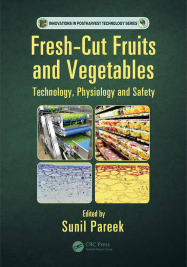Fresh Cut Fruits and Vegetables Technology Physiology and Safety
Material type: TextLanguage: English Series: Innovations in Postharvest Technology SeriesPublication details: Boca Raton, FL : CRC Press, c2017Description: XXIX, 593 p. : illISBN:
TextLanguage: English Series: Innovations in Postharvest Technology SeriesPublication details: Boca Raton, FL : CRC Press, c2017Description: XXIX, 593 p. : illISBN: - 9781498729949
- 634 PAR
| Item type | Current library | Collection | Shelving location | Call number | Copy number | Status | Date due | Barcode |
|---|---|---|---|---|---|---|---|---|
 Reference Collection
Reference Collection
|
Reference Section | Department of Food Engineering | Department of Food Engineering | 634 PAR | 2022-23 | Available | 98041 |
Biography
Dr. Sunil Pareek obtained his PhD in horticulture (PHT) from Rajasthan Agricultural University, Bikaner, India. He is an associate professor (PHT) in the Department of Agriculture and Environmental Sciences, National Institute of Food Technology Entrepreneurship and Management (NIFTEM), Kundli, Haryana, India. Dr. Pareek is principal or co-principal investigator on several fruit, tuber crop, processed products, and integrated farming projects. He has made a significant contribution in postharvest technology and processing of underutilized fruits. He has guided several post graduate students, has published extensively, and is the recipient of the University Outstanding Services Award 2013, University Best Team Research Award 2014, Young Scientist Award 2012, HS Mehta Young Scientist Award 2012, JISL Fellowship 2014, and the Fellow Award of the Confederation of Horticultural Associations of India.
SUMMARY:
Because they meet the needs of today’s consumers, fresh-cut plant products are currently one of the hottest commodities in the food market of industrialized countries. However, fresh-cut produce deteriorates faster than the correspondent intact produce. The main purpose of Fresh-Cut Fruits and Vegetables: Technology, Physiology, and Safety is to provide helpful guidelines to the industry for minimizing deterioration, keeping the overall quality, and lengthening the shelf life. It provides an integrated and interdisciplinary approach for accomplishing the challenges, where raw materials, handling, minimal processing, packaging, commercial distribution, and retail sale must be well managed. It covers technology, physiology, quality, and safety of fresh-cut fruits and vegetables.
In this book, the chapters follow a logical sequence analyzing most of the important factors affecting the main characteristics of fresh-cut horticultural products. The most relevant technologies to prevent deterioration and improve final overall quality of fresh-cut commodities are described in detail. This book covers the basics of the subject from quality preservation, nutritional losses, physiology, and safety to industry-oriented advancements in sanitization, coatings, and packaging. It examines such novel preservation technologies as edible coatings, antimicrobial coatings, natural antimicrobials, gum arabic coatings, and pulsed light treatments. Minimal processing design and industrial equipment are also reviewed. With its international team of contributors, this book will be an essential reference work both for professionals involved in the postharvest handling of fresh-cut and minimally processed fruits and vegetables and for academic and researchers working in the area.
